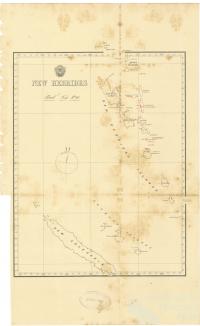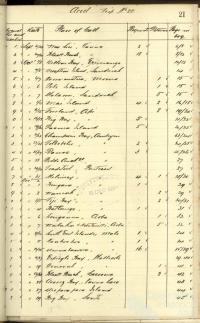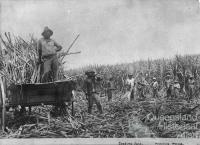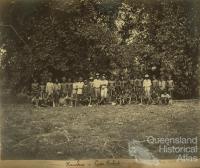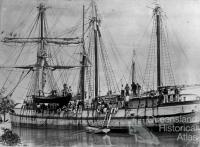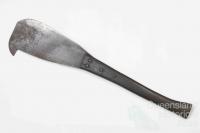- Home
- Quintessential Queensland
- Distinctiveness
- Perceptions
- Perceptions: how people understand the landscape
- From runs to closer settlement
- Geological survey of Queensland
- Mapping a new colony, 1860-80
- Mapping the Torres Strait: from TI to Magani Malu and Zenadh Kes
- Order in Paradise: a colonial gold field
- Queensland atlas, 1865
- Queensland mapping since 1900
- Queensland: the slogan state
- Rainforests of North Queensland
- Walkabout
- Queenslanders
- Queenslanders: people in the landscape
- Aboriginal heroes: episodes in the colonial landscape
- Australian South Sea Islanders
- Cane fields and solidarity in the multiethnic north
- Chinatowns
- Colonial immigration to Queensland
- Greek Cafés in the landscape of Queensland
- Hispanics and human rights in Queensland’s public spaces
- Italians in north Queensland
- Lebanese in rural Queensland
- Queensland clothing
- Queensland for ‘the best kind of population, primary producers’
- Too remote, too primitive and too expensive: Scandinavian settlers in colonial Queensland
- Distance
- Movement
- Movement: how people move through the landscape
- Air travel in Queensland
- Bicycling through Brisbane, 1896
- Cobb & Co
- Journey to Hayman Island, 1938
- Law and story-strings
- Mobile kids: children’s explorations of Cherbourg
- Movable heritage of North Queensland
- Passages to India: military linkages with Queensland
- The Queen in Queensland, 1954
- Transient Chinese in colonial Queensland
- Travelling times by rail
- Pathways
- Pathways: how things move through the landscape and where they are made
- Aboriginal dreaming paths and trading ways
- Chinese traders in the nineteenth century
- Introducing the cane toad
- Pituri bag
- Press and the media
- Radio in Queensland
- Red Cross Society and World War I in Queensland
- The telephone in Queensland
- Where did the trams go?
- ‘A little bit of love for me and a murder for my old man’: the Queensland Bush Book Club
- Movement
- Division
- Separation
- Separation: divisions in the landscape
- Asylums in the landscape
- Brisbane River
- Changing landscape of radicalism
- Civil government boundaries
- Convict Brisbane
- Dividing Queensland - Pauline Hanson’s One Nation Party
- High water mark: the shifting electoral landscape 2001-12
- Hospitals in the landscape
- Indigenous health
- Palm Island
- Secession movements
- Separate spheres: gender and dress codes
- Separating land, separating culture
- Stone walls do a prison make: law on the landscape
- The 1967 Referendum – the State comes together?
- Utopian communities
- Whiteness in the tropics
- Conflict
- Conflict: how people contest the landscape
- A tale of two elections – One Nation and political protest
- Battle of Brisbane – Australian masculinity under threat
- Dangerous spaces - youth politics in Brisbane, 1960s-70s
- Fortress Queensland 1942-45
- Grassy hills: colonial defence and coastal forts
- Great Shearers’ Strike of 1891
- Iwasaki project
- Johannes Bjelke-Petersen: straddling a barbed wire fence
- Mount Etna: Queensland's longest environmental conflict
- Native Police
- Skyrail Cairns (Research notes)
- Staunch but conservative – the trade union movement in Rockhampton
- The Chinese question
- Thomas Wentworth Wills and Cullin-la-ringo Station
- Separation
- Dreaming
- Imagination
- Imagination: how people have imagined Queensland
- Brisbane River and Moreton Bay: Thomas Welsby
- Changing views of the Glasshouse Mountains
- Imagining Queensland in film and television production
- Jacaranda
- Literary mapping of Brisbane in the 1990s
- Looking at Mount Coot-tha
- Mapping the Macqueen farm
- Mapping the mythic: Hugh Sawrey's ‘outback’
- People’s Republic of Woodford
- Poinsettia city: Brisbane’s flower
- The Pineapple Girl
- The writers of Tamborine Mountain
- Vance and Nettie Palmer
- Memory
- Memory: how people remember the landscape
- Anna Wickham: the memory of a moment
- Berajondo and Mill Point: remembering place and landscape
- Cemeteries in the landscape
- Landscapes of memory: Tjapukai Dance Theatre and Laura Festival
- Monuments and memory: T.J. Byrnes and T.J. Ryan
- Out where the dead towns lie
- Queensland in miniature: the Brisbane Exhibition
- Roadside ++++ memorials
- Shipwrecks as graves
- The Dame in the tropics: Nellie Melba
- Tinnenburra
- Vanished heritage
- War memorials
- Curiosity
- Curiosity: knowledge through the landscape
- A playground for science: Great Barrier Reef
- Duboisia hopwoodii: a colonial curiosity
- Great Artesian Basin: water from deeper down
- In search of Landsborough
- James Cook’s hundred days in Queensland
- Mutual curiosity – Aboriginal people and explorers
- Queensland Acclimatisation Society
- Queensland’s own sea monster: a curious tale of loss and regret
- St Lucia: degrees of landscape
- Townsville’s Mount St John Zoo
- Imagination
- Development
- Exploitation
- Transformation
- Transformation: how the landscape has changed and been modified
- Cultivation
- Empire and agribusiness: the Australian Mercantile Land and Finance Company
- Gold
- Kill, cure, or strangle: Atherton Tablelands
- National parks in Queensland
- Pastoralism 1860s–1915
- Prickly pear
- Repurchasing estates: the transformation of Durundur
- Soil
- Sugar
- Sunshine Coast
- The Brigalow
- Walter Reid Cultural Centre, Rockhampton: back again
- Survival
- Survival: how the landscape impacts on people
- Brisbane floods: 1893 to the summer of sorrow
- City of the Damned: how the media embraced the Brisbane floods
- Depression era
- Did Clem Jones save Brisbane from flood?
- Droughts and floods and rail
- Missions and reserves
- Queensland British Food Corporation
- Rockhampton’s great flood of 1918
- Station homesteads
- Tropical cyclones
- Wreck of the Quetta
- Pleasure
- Pleasure: how people enjoy the landscape
- Bushwalking in Queensland
- Cherbourg that’s my home: celebrating landscape through song
- Creating rural attractions
- Festivals
- Queer pleasure: masculinity, male homosexuality and public space
- Railway refreshment rooms
- Regional cinema
- Schoolies week: a festival of misrule
- The sporting landscape
- Visiting the Great Barrier Reef
By:
Imelda Miller White Society used them as labourers when needed and discarded them when no longer needed: they were coerced and expendable labour
Human Rights & Equal Opportunity Commission 1992
Australian South Sea Islanders today consider our ancestors to have been the Sugar Slaves. South Sea Islanders, transported to Australia as a cheap source of labour, worked in the development and establishment of the new Queensland sugar industry. They came predominately from Vanuatu and the Solomon Islands; but also New Caledonia, Fiji, Gilbert Islands, New Ireland, and Milne Bay Provinces of Papua New Guinea. These peoples were collectively referred to time Kanakas, but we prefer to be called South Sea Islanders as the word 'kanaka' is considered derogatory by Islander communities in the Pacific and Australia.
Between 1863 and 1904, 62,000 South Sea Islanders were brought to Australia to work in the sugar industry. They arrived at several major ports along the eastern coastline including Brisbane, Maryborough, Bundaberg, Rockhampton, Mackay, Bowen, Townsville, Innisfail and Cairns.
Recruitment of sugar slaves
One of the most controversial aspects of the labour trade centres on how Islanders were ‘recruited’. Official documentation conflicts with oral history accounts that have been passed down through generations of South Sea Islanders. Were they forced, coerced, deceived or persuaded to leave their homes and travel by ship to Queensland? The answer to that is that all these methods were used.
Some Islanders were kidnapped or ‘blackbirded’ by Europeans who used their knowledge of Pacific Islander societies to trade and coerce women, men and children to leave their home islands. Older generations recall stories of ancestors being sold like cattle at the shipping docks in Queensland.
When the first Islanders arrived in 1863 there was very little legislation to protect them. The Polynesian Labourers Act 1868 was introduced to regulate the labour trafficking of Pacific Islanders into Queensland. Its aim was to stop the practice of kidnapping of Islanders or ‘blackbirding’ and the ill treatment and exploitation of Islanders on the boats and on the farms.
None of our ancestors came to Queensland with full knowledge of how it would affect their lives.
The labour trade
The trade in Pacific Islander labourers was formalised with the introduction of the Pacific Labourers Act 1880 (Queensland). This provided a monitoring system for labour vessels and indentured labour. It aimed to regulate and control the process to ensure paid labour for Islanders but maintained financial benefits of a slavery system. Essentially cheap labour was provided by coerced workers who could not resign. South Sea Islanders were restricted to working in the sugar industry by legislation that stated they had to work within a 30 mile limit from the coastline.
Harsh working conditions
Regardless of how they were recruited the exploitation of Islanders was widespread. A few Islanders worked under formal contracts established by the Queensland Master and Servants Act 1861. All were controlled by draconian legislation.
Islanders were made to sign three year work contracts. Many could not read and a signature was a fingerprint. While white labourers earned £30 each year, Islanders were paid in weekly rations, with their wage of only £6 per year paid at the end of the contract.
The Queensland sugar industry was literally built on the backs of South Sea Islanders. Men, women and children had to work long hours and in harsh conditions akin to slavery. They were required to clear heavy rainforest and scrub, and to plant, maintain and harvest the cane.
Social conditions
Despite the controls over their lives, Islanders maintained their cultural connections even while working as indentured labourers. South Sea Islanders usually lived in some kind of barracks style housing on the sugar cane farms. Some preferred to live in traditional grass hut style accommodation, with separate sleeping arrangements for women and men. The village layout was similar to those in the islands, families together and single men’s quarters separated away from the families.
South Sea Islanders were vulnerable to disease and poor health care in Australia. In their new home of Queensland, South Sea Islander men, women and children were exposed to people who carried diseases that the Islanders would have had little or no prior contact with in their home islands. As a consequence Islanders caught European diseases. Combined with a culturally and nutritionally inadequate diet of beef or mutton, potatoes, bread, tea and sugar, this was a recipe for an Islander health disaster. The Islanders had to work while sick and because there was little or inadequate health care, many died in the paddocks or at the farms. The result was a very high death rate for South Sea Islanders compared to that of Europeans.
Australian South Sea Islanders were segregated from mainstream society and excluded from services. Eventually, in the 1880s hospitals were set up for South Sea Islanders in Maryborough, Ingham and Mackay. Some hospitals created separate ‘Kanaka’ wards.
An end to labour trade
The trade in Pacific Labour drew criticism from many sectors. But it was the White Australia Policy and the desire to protect jobs for white Australians that finally ended the Labour trade. In 1901 the Labour Trade formally ceased and the Australian government took steps to deport South Sea Islanders to their home islands. This was impossible and undesirable for many, and resulted in more hardships and discrimination for those who had made Queensland home.

